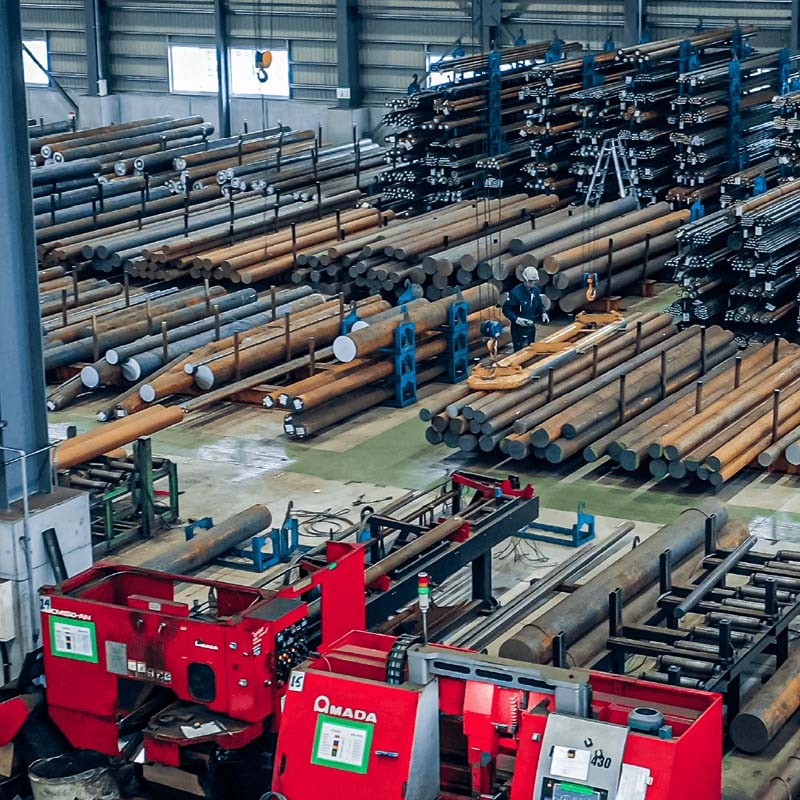
High speed tool steel comprises a set of tool steel alloys named for their capacity to cut materials faster than traditional high-carbon steels previously used in cutting tools. This is on account of exceptional hardness, abrasion resistance and resistance against softening at high temperatures, owing to the alloying metals and heat treatment used. We follow the American Society for Testing and Materials in its definition of high speed steel as given in Specification A600-79—a high-carbon steel containing tungsten and/or molybdenum, along with chromium, vanadium and sometimes cobalt.
The heat treatment used is also a major component of what defines high speed steel, as its martensitic structure contributes to its high hardness. This is achieved by austenizing to nearly the steel’s melting temperature, then quenching in a salt bath or by air cooling and multiple tempering cycles to convert any remaining austenite to martensite.
Though the term “high speed tool steel” describes multiple alloys, these traits are common to all of them:
High alloy content, primarily tungsten or molybdenum, with lesser amounts of chromium, vanadium and cobalt;
High carbon content—a minimum of 0.65% by weight, but commonly anywhere from 0.8% to 1.5% carbon content;
Rockwell hardness of at least 64 HRC at room temperature;
A heat treatment process that produces a high quantity of complex metallic carbides—chiefly tungsten, molybdenum and vanadium carbides—suspended in a steel substrate, which results in hardness and wear resistance.
High Speed Tool Steel Processes
High-speed tool steel has a complex process flow, and adopts advanced technology, whether it is heat treatment process, forging process or surface treatment process, it is constantly optimized and improved.
(1) Vacuum melting of high-speed tool steel
One of the key processes in the manufacture of high-speed tool steel is vacuum smelting. Vacuum smelting uses high-temperature and high-pressure electric arc furnaces or induction furnaces to purify metals after high-temperature smelting under vacuum. This can effectively reduce the content of impurities in the high-speed tool steel and play a role in purification.
(2) High speed tool steel forging process
The forging of high speed tool steel usually adopts forging-rolling technology, which is a process in which high-speed steel ingots are heated, forged and pressed, and then rolled into products. In addition, high speed tool steel needs to be repeatedly forged when manufacturing tools, so as not to cause problems that cannot be formed due to excessive hardness, and to make the carbides in the steel evenly distributed.
(3) High speed tool steel heat treatment process
The high-speed tool steel is heat-treated by means of preheating, quenching, and triple tempering to achieve the purpose of improving the performance of the steel, increasing the hardness and wear resistance. The preheating of high-speed tool steel is usually carried out in two steps of 600-650°C and 800-850°C. The second preheating can reduce the stable temperature difference between high-temperature furnaces, thereby reducing the formation of carbides. Before quenching high-speed tool steel, it is necessary to determine the type and composition of the material and select the heating temperature according to the demand. After quenching, high-temperature tempering at 560°C is also a quenching and tempering treatment, and three times of tempering are required. After tempering three times, the residual austenite can be decomposed and its strength and toughness can be improved.
High Speed Tool Steel Applications
As a special tool steel with good wear resistance, high-precision machinability, high red hardness, and high strength, high-speed tool steel has a wide range of applications. It not only plays an important role in the manufacturing industry, but also is used in aerospace, automobiles, In the field of mold and machining.
1.Automobile field: In automobile manufacturing, high speed tool steel is mainly used in the manufacture of brake systems, which can be used to manufacture key components such as brake discs, engines, brake pads, transmissions, and steering gears, which can improve the performance and reliability of automobiles.
2.Manufacture of cutting tools: High-speed tool steel has excellent cutting performance and can be used to process various metal materials. It is mainly used to manufacture various cutting tools with high efficiency, such as knives, milling cutters, blades, turning tools, drills and saw blades, etc.
3.Aerospace field: The quality of every part in the manufacture of aircraft is very strictly controlled, and raw materials with excellent performance are required to be manufactured. Ensure the safety and reliability of aircraft. High speed tool steel has high hardness, high wear resistance and high corrosion resistance, and can be used to manufacture high-precision parts such as aircraft engines, turbine blades, turbines, missile parts, and blisks.
4.Mold manufacturing: various molds can be manufactured, including hot work dies, stamping dies and cold stamping dies, etc., such as forging dies, drawing dies, casting dies, die-casting dies, cutting dies and trimming dies, etc.
5.Machinery manufacturing: high speed tool steel can manufacture various machine tools, forging presses, mechanical parts and casting machines, etc.
6.Electronic equipment field: It can be used to manufacture various precision parts and improve the performance and reliability of electronic equipment.
7.Manufacture of bearings: high-speed tool steel can manufacture various bearings, such as rolling bearings, sliding bearings and so on.
Regardless of past or future development, high speed tool steel is a very important tool steel in many fields, and has broad application prospects and important economic value.







|

|

|

|

|
| Timely Info | Independent | Platform | Multiple guarantees | Self-operated storage |
| About us | Channel | Useful tools |
|---|---|---|
| About China Steel Market | Prices | Steel weight calculation |
| Contact us | Answers | |
| Terms & Conditions | Inventory | |
| Privacy Policy | Help |
Hot search words: